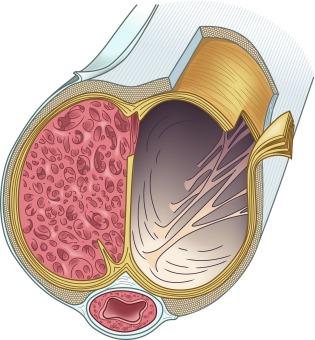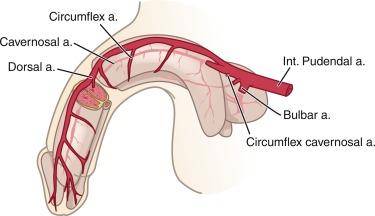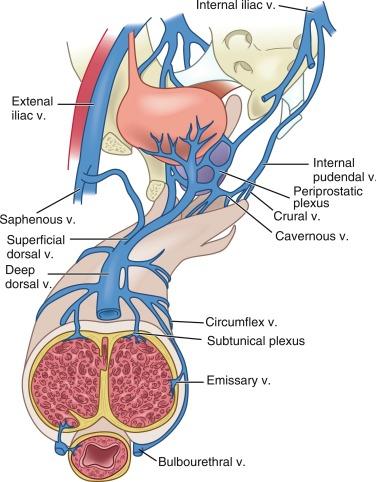Physical Address
304 North Cardinal St.
Dorchester Center, MA 02124
The first historical descriptions of erectile dysfunction (ED) date back to Egyptian papyrus, nearly 4000 years ago. Egyptian scholars described two types of ED: a “natural” form in which the man was not capable of performing the sex act and a “supernatural” form rooted in evil charms and spells. Ancient thinkers, such as Hippocrates and Aristotle, also theorized on the etiology of ED. However, the first accurate depiction of penile anatomy and rudimentary analysis of erection was not published until 1585, when Ambroise Paré described it in his Ten Books on Surgery and the Book of Reproduction . In these texts, Paré portrayed the penis as a tube with concentric coats of nerves, veins, arteries, two “ligaments” composed of the corpora cavernosa, and the urinary tract.
Over the succeeding centuries, there has been considerable investigation into the hemodynamic and anatomic mechanisms of the male erection. The modern understanding of erectile physiology has been delineated only in the past 30 years. Central to our current theories of erectile physiology is the role of smooth muscle in control of arterial and venous flow, the architecture of the tunica albuginea, the role of nitric oxide (NO) as the principal neurotransmitter regulating tumescence, and the function of phosphodiesterases (PDEs) for detumescence. Recent research on the role of endothelial regulation of smooth muscle, the influence of ion channels, and the integral function of endothelial gap junctions has furthered our understanding. This chapter will review these findings, as well as the prevalence, clinical evaluation, diagnostic testing, medical and surgical management, public health implications, and current guidelines regarding vasculogenic ED in detail.
In 1992 the National Institutes of Health convened a Consensus Development Conference on Impotence. The group renamed impotence as “male erectile dysfunction” and defined it as “the inability to achieve or maintain an erection sufficient for satisfactory sexual performance.” Furthermore, they noted that ED represents the most appropriate term, given that sexual desire, orgasm, and ejaculation may be intact, despite the inability to achieve or maintain erection.
Multiple schema have been proposed to classify the different types of ED. Broadly, ED can be described in terms of organic and psychogenic dysfunction ( Box 27.1 ). The main thrust of this chapter will center on vasculogenic ED, which is composed of impaired endothelial function, arterial occlusive disease, veno-occlusive dysfunction, and structural changes to the corpora cavernosa.
ED is quite common, affecting approximately 30 million men in the United States. Several population-based studies have been performed to address male sexual function and specifically the prevalence and incidence of ED in the American male population. The National Health Social and Life Survey (NHSLS) was a national cross-sectional interview survey in 1992 of 1410 American men between the ages of 18 and 59 years. In the study group, the prevalence of ED in men aged 18 to 29 years was 7%, aged 30 to 39 was 9%, aged 40 to 49 was 11%, and aged 50 to 59 was 18%. The Massachusetts Male Aging Study (MMAS), a longitudinal population-based study, evaluated 1709 men between the ages of 40 and 70 years who returned questionnaires about a broad range of physiologic measures, demographic information, and self-reported sexual function. The participants were surveyed between the years 1987 and 1989 and then reevaluated between 1995 and 1997. In this series, the age-adjusted prevalence of significant ED was 39% in men with coronary artery disease, 25% in men with diabetes mellitus, and 15% in men with hypertension. The incidence of ED on reevaluation was 25.9 cases per 1000 men per year (95% confidence interval [CI], 22.5 to 29.9). Using these data, it was estimated that for white men, 617,715 new cases of ED would present in the 40 to 69 age group each year. Data from European and Brazilian researchers suggest a similar incidence of ED in their respective countries.
The prevalence of ED is expected to increase as the incidence of obesity and cardiovascular and metabolic disease increase. As of 1995 an estimated 152 million men worldwide had ED, and this is predicted to increase to 322 million men by 2025. ED is often referred to as a “canary in a coal mine” because it can be an indication of underlying systemic vascular disease. The National Health and Nutritional Examination Survey (NHANES) cross-sectional study revealed that 90% of men with ED had at least one major cardiovascular risk factor (diabetes mellitus, hypercholesterolemia, hypertension, smoking). Furthermore, several longitudinal studies have shown that men with ED are at an increased risk for serious cardiac events and mortality compared with men without ED. A recent follow-up to the NHANES cohort found that the men who reported ED at the time of the initial study were found to have a 70% increased risk of premature all-cause mortality over the duration of the study. This led the Princeton Consensus Conference (PCC), a multispecialty collaborative tradition dedicated to optimizing sexual function and preserving cardiovascular health, to issue new recommendations concerning the work-up of ED. Held in 2010, the third PCC added recommendations for stringent evaluation and management of cardiovascular risk in men with ED and no known cardiovascular disease (CVD). These recommendations will be discussed further when discussing management of ED.
Although ED has traditionally been thought of as a disease of the older man, the global epidemic of obesity and associated comorbidities has led to an increase in the rate of ED in younger men. Obesity is an independent risk factor for ED, with a recent study revealing rates of ED in 22.4% versus 13.4% of men with a body mass index > 30 kg/m 2 and < 25 kg/m 2 , respectively. Diabetes mellitus is a major risk factor of ED given its vascular, neurologic, and endocrine disturbances; and we have likewise seen increased prevalence of diabetes in the younger population.
The functional anatomy of the human penis is composed of several key components. Principally, these are three cylindrical structures—two corpora cavernosa surrounded by a tough tunica albuginea and the solitary corpus spongiosum, which contains the urethra. The vascular components include arteries and arterioles, highly compliant sinusoids within the corpora cavernosa, and compressible venules and veins.
The corpora cavernosa are paired, spongy cylinders that lie on the superior aspect of the penis. They are enveloped by the tunica albuginea. The proximal ends of the corpora are separate structures anchored at the ischial ramus. The corpora then fuse underneath the pubic ramus and share a common septum distally towards the glans.
Within the corpora, interconnected sinusoids are enveloped by trabeculae of smooth muscle, collagen, and elastin ( Fig. 27.1 ). The sinusoidal smooth muscle is in intimate association with the cavernous nerves and the helicine arteries within the penis. The sinusoids are tonically constricted during the flaccid state. Arterial blood flow diffuses through larger central sinusoids to smaller peripheral sinusoids. In the flaccid state, this slow diffusion of arterial blood results in blood gas values similar to venous blood. During sexual stimulation, a release of neurotransmitters causes the smooth muscle around the sinusoids to relax. This results in the rapid influx of arterial blood, subsequent entrapment of blood within these expanding sinusoids, and occlusion of veins traversing the tunica albuginea. Subsequent tumescence results in pressure increases of several hundred millimeters of mercury and blood gas values approaching arterial levels.

The interior of the glans and corpus spongiosum share a similar sinusoidal architecture as the corpora cavernosa. However, the tunica surrounding the spongiosum is thinner and is completely absent around the glans. The corpus spongiosum is a highly compliant body that houses the urethra and facilitates the expulsion of semen. The glans is exquisitely sensitive and conical in shape, eases intromission, and forms a cushion for the rigid corporal bodies. These areas engorge in a similar fashion as the corpora cavernosa, however to a lesser degree, largely due to an absence of the tunica albuginea and diminished venous trapping.
The tunica albuginea is composed primarily of tough type 1 collagen with a minority component of more flexible type III collagen and elastin. It is arranged in a bilayer, with inner circular layers and outer longitudinal layers (see Fig. 27.1 ). Intervening struts traverse the body of the corpora cavernosa and provide further support. The longitudinal layers of the tunica are present from the glans to the proximal crura, where each corporal body inserts into its ischial ramus to form a foundation for support of the erect penis. Emissary veins ( Fig. 27.2 ) pierce the tunica albuginea. During engorgement, these veins become compressed and allow entrapment of blood within the penis.

The internal pudendal artery, a branch of the internal iliac artery, is the principal source of blood flow to the penis. Up to 70% of men may have accessory pudendal branches that originate from the external iliac, obturator, or vesical arteries. The internal pudendal artery gives rise to the penile artery, which in turn branches into the dorsal, bulbourethral, and cavernous arteries ( Fig. 27.3 ). The cavernous artery supplies the corpus cavernosum via helicine arteries, which lie in close approximation to the sinusoidal tissue. During erection, these vessels dilate, resulting in engorgement.

The venous drainage originates from the three corporal bodies. Venules interdigitate through the cavernosal sinusoids and coalesce below the tunica albuginea into a subtunical plexus. The plexi then form emissary veins that penetrate the tunica albuginea. From there, numerous subcutaneous veins course along the shaft of the penis to form the superficial dorsal vein and a deep dorsal venous system, which in turn drain into the saphenous vein and retropubic venous plexus, respectively ( Fig. 27.4 ; see Fig. 27.2 ).

Penile innervation occurs via both autonomic (parasympathetic and sympathetic) and somatic (motor and sensory) pathways. Erection and detumescence are largely regulated via the autonomic system. Sympathetic and parasympathetic nerves coalesce to form the cavernous nerve, which penetrates the corpora cavernosa to exert its effect on erection ( Fig. 27.5 ). Sensation and contraction of penile musculature occurs via the somatic nerves.

Become a Clinical Tree membership for Full access and enjoy Unlimited articles
If you are a member. Log in here